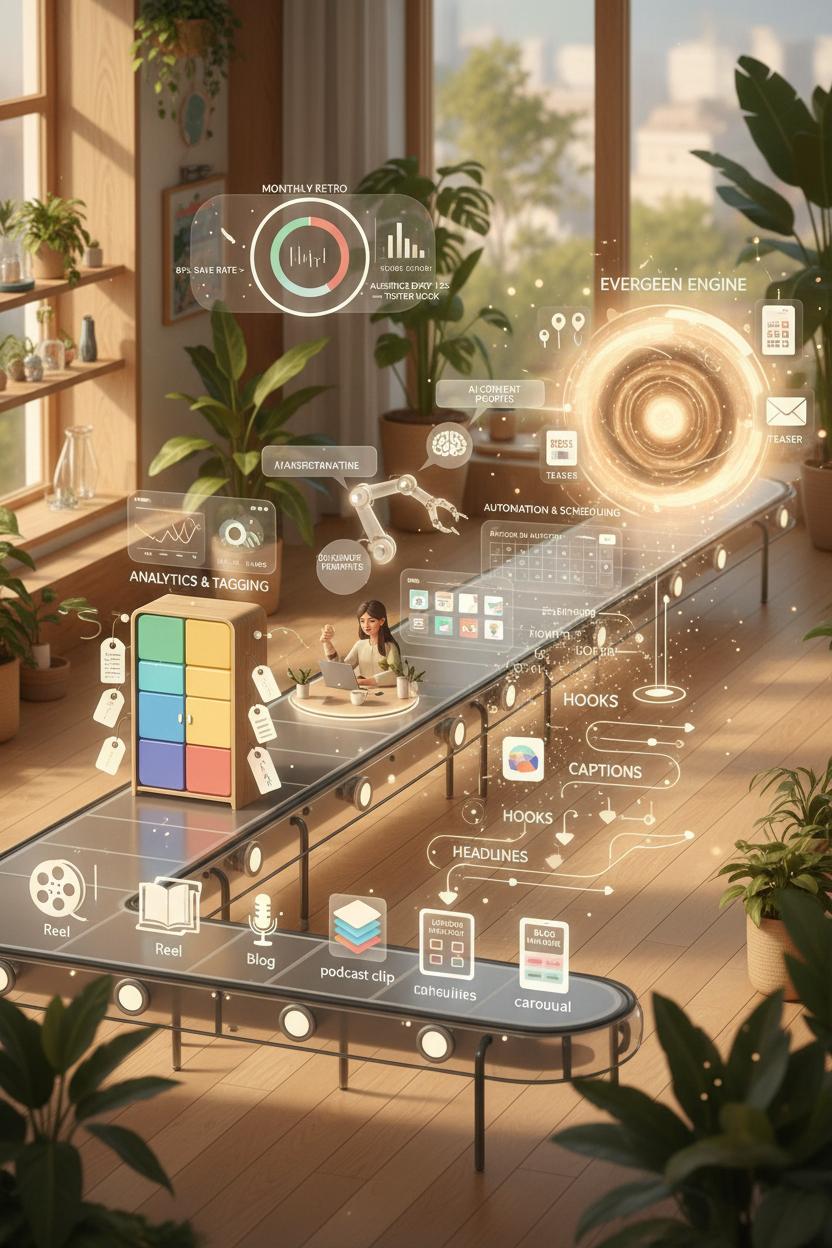Ready to ditch content chaos? In this guide, I’ll show you content automation in five simple steps—how to brainstorm AI content, streamline social media scheduling, and build a repeatable marketing workflow that saves hours. Learn smart content repurposing with plug-and-play Notion templates and Canva templates, plus my favorite AI marketing tools, social media scheduler, and content automation software to keep everything on autopilot. Pin this for later and start creating more with less!
Step 1: Map Your Marketing Workflow with Notion Templates for Repeatable Content Automation

Before you sprint into creation mode, take an hour to map your entire marketing workflow inside Notion so every post, video, or email follows the same cozy, repeatable path. Start with a simple Content Hub built from Notion templates: one master database for ideas, drafts, designs, approvals, and publish dates, with views for each stage. Add properties you’ll use over and over—campaign theme, content type, target platform, CTA, keywords, owner, due date, and links to assets—so your process feels like a neatly labeled pantry. Create a status pipeline (Idea → Draft → Edit → Design → Schedule → Published → Repurpose) and make it visual with board views that let you drag content cards forward as you go. The goal is to build a living map of your marketing workflow that keeps your brain clear and your calendar tidy.
Next, bake in content repurposing from the start. For each anchor piece (say, a blog or video), include a “Repurpose Recipes” section in your template with ready-to-go prompts for Instagram carousels, email snippets, Pinterest descriptions, and short-form scripts. Store brand-approved hooks, CTAs, and tone notes so AI content stays on voice. Link a Design sub-page where you’ll drop Canva templates and file references, and an Assets gallery for thumbnails, reels, and cover images. When your draft hits “Design,” your template already knows what to call the file, where to save it, and which platforms it will feed. This is content automation at its calmest: everything has a home, and every piece knows its next step.
Finally, connect your Hub to the tools that help you ship. If you use a social media scheduler, include platform fields and a scheduling checklist so handoff is frictionless. If you lean on AI marketing tools or content automation software, keep prompt libraries and style guides right inside Notion for consistent AI content generation. You can even trigger reminders or handoffs using Notion buttons and lightweight integrations, turning your template into an assembly line that runs while you sip your latte. With the right Notion templates stitched to your favorite social media scheduling flow—and your trusty Canva templates at the ready—you’ll move from scattered tasks to a smooth, repeatable system that saves time without sacrificing creativity.
Step 2: Create AI Content with AI Marketing Tools and Content Automation Software

Now that your ideas are collected, it’s time to turn them into AI content that feels polished, on-brand, and ready to share. Think of this step like styling a capsule wardrobe: you’ll mix a few hero pieces into many gorgeous looks. Start by dropping your brief into your favorite AI marketing tools and let them draft a blog outline, headline options, and a few caption “families” (short, medium, punchy, thoughtful) you can reuse. Feed the tools your tone cues, brand phrases, and customer pain points so the voice stays consistent. Save these prompts inside Notion templates to build a repeatable marketing workflow you can run every week without reinventing the wheel. For visuals, plug your key messages into Canva templates and let the design pieces snap into place—pin graphics, carousels, and story frames that all match, like a coordinated set you can pull from anytime. This is where content automation starts to shine: you’re not just creating more, you’re creating smarter, with systems that remember your style.
Once your core post is drafted, let content repurposing do the heavy lifting. Turn the long article into a carousel outline, a 30-second reel script, an email teaser, and a set of Pin descriptions—then have your content automation software generate alt text, UTM tags, and first-pass hashtags. Batch three to five variations so you can rotate them later without feeling repetitive. Drop everything into your social media scheduler, set your social media scheduling cadence (think: Monday blog, Wednesday carousel, Friday reel, weekend Pins), and add seasonal reminders so future-you can reshare evergreen winners. The beauty here is momentum: the AI content you made today will keep working next month, next quarter, and beyond. If you want to go extra tidy, keep a “ready-to-post” board with links, assets, and swipeable copy saved in Notion templates, plus a mini brand guide for colors, hooks, and CTAs. With the right AI marketing tools, a flexible social media scheduler, and a library of Canva templates, you’ll move from blank page to publish-ready in an afternoon—and every piece you make will have two or three built-in spin-offs waiting to go.
Step 3: Design On-Brand Visuals Using Canva Templates for Seamless Content Repurposing

Here’s where your workflow gets pretty. Open Canva and build a small, reliable library of on-brand Canva templates that you can reuse across every channel, so your visuals feel like a cozy, cohesive home no matter where they show up. Start with your brand kit—colors, fonts, logos—and design a “family” of templates for square posts, carousels, Stories, Reels covers, Pins, blog headers, and email banners. Keep the layouts simple and modular: one for quotes, one for tips, one for stats, one for product features. The goal isn’t perfect design; it’s consistent, repeatable design that makes content automation effortless. If you’re drafting AI content for captions or headlines, paste those snippets right into your templates and watch the pieces come together like mood-board magic.
To make content repurposing seamless, create placeholder fields inside each template—headline, supporting text, CTA, URL, and optional photo—so swapping content takes seconds. Batch design by duplicating a master page and dropping in new copy from your blog or video transcript. Use resize features to create platform-specific versions in one swoop, then export with a tidy naming convention (PostType_Topic_Date) to keep everything organized. If you love systems, stash links to your template set in Notion templates and pair them with simple checklists: export formats, alt text prompts, and UTM notes. This is where AI marketing tools shine—have them generate alt text, punchy hooks, or subtitle overlays—while your templates keep everything looking unmistakably “you.” Think of it as gentle content automation software for your visuals.
Finally, plug the output into your social media scheduler for smooth social media scheduling. Upload each size to the right folder, paste in those AI content captions, and queue across platforms without second-guessing your brand. Your marketing workflow flows faster when the visuals are pre-styled and the copy is pre-written; all you’re doing is matching pieces and pressing schedule. Keep iterating your template family as you learn what drives clicks and saves. With a tiny investment upfront, your visuals become an always-on system—ready for fast launches, seasonal campaigns, and daily posts—without starting from scratch every time.
Step 4: Automate Social Media Scheduling with a Social Media Scheduler Across Platforms

You’ve drafted the posts, prepped the visuals, and your ideas are humming—now let’s let your content work while you sleep. This is where social media scheduling becomes your secret superpower. Connect a social media scheduler to your channels—Instagram, Pinterest, LinkedIn, TikTok, and Facebook—and set posting windows that match audience hotspots in each time zone. Build a weekly cadence with evergreen queues for your best-performing pieces and sprinkle in fresh drops. I like to create “content buckets” for tips, stories, product spotlights, and behind-the-scenes, then map them across platforms so the feed feels cohesive but never copy-pasted. Add UTM links, save your hashtag sets, and turn on auto-publish for features like first-comment hashtags and link-in-bio updates. With solid content automation in place, your marketing workflow stops being a scramble and starts feeling like a rhythm.
This is also the perfect moment to lean on AI content for quick variations. Use AI marketing tools inside your content automation software to rewrite headlines for different audiences, shorten captions for Reels, and expand copy for LinkedIn. For visuals, batch-design with Canva templates—pin covers, carousel frames, story stickers—then drop them into your scheduler in one swoop. Keep your ideas organized with Notion templates: a content calendar, caption banks, and a repurposing tracker so every blog post becomes a carousel, a pin, a short video, and an email snippet. Most social media schedulers let you customize posts per platform—crop a vertical pin, swap the thumbnail for Reels, tweak alt text for accessibility—without rebuilding the entire post. That’s content repurposing at its most joyful: one idea, many outfits.
Finally, create a gentle review ritual. Schedule a weekly “optimize and approve” block to skim upcoming posts, adjust hooks, and re-sequence anything time-sensitive. Check performance inside the scheduler and tag winners for evergreen queues; retire what’s flat or refresh it with a new angle. Over time, your library becomes a loop of proven assets, and your social feeds keep breathing with minimal effort. If you love tool stacks, a simple combo of a reliable social media scheduler, a few AI marketing tools, organized Notion templates, and polished Canva templates can carry the load. Step 4 turns content automation from a buzzword into a calming habit—your posts go out, your brand stays present, and you get your evenings back.
Step 5: Scale Content Repurposing and Optimize Your Marketing Workflow with Analytics

This is the cozy, scale-it-with-style moment where your content starts working like a well-loved capsule wardrobe. Let analytics be your guide and give your best ideas new outfits across every channel. Create a simple feedback loop: tag each piece by topic, format, and funnel stage inside color-coded Notion templates, then track performance with UTM links and a lightweight dashboard. Watch the signals that really matter—saves, watch time, retention, click-throughs, reply rate—and let those metrics tell you which stories deserve a second (or fifth) life. When a post clears a threshold, spin up an instant repurpose plan: turn a high-retention Reel into a blog mini-guide, a carousel into a Pinterest pin set, or a podcast clip into an email teaser. This is content repurposing with intention, not guesswork.
Layer in content automation to do the heavy lifting. Use AI content prompts trained on your top performers to draft variations, then drop them into branded Canva templates to keep everything stunning and on-brand in minutes. Pair that with a social media scheduler and content automation software so your batches drip out on autopilot while you sip your coffee. Many AI marketing tools now atomize long-form posts into short hooks, captions, and headlines, so you can A/B test scroll-stopping intros or thumbnail text without burning creative energy. Keep your social media scheduling thoughtful: map formats to platform-native behaviors (quick cuts for Reels, saves-first carousels for Instagram, keyword-forward ideas for Pinterest) and let your workflow run like a gentle assembly line.
Finally, optimize the entire marketing workflow with a monthly retro. Sort content by topic cluster and format to see what consistently compels action. Retire what underperforms, double down on winners, and document your learnings inside Notion templates so every new idea starts smarter. Use analytics to set trigger rules—if a post hits 8%+ save rate, auto-queue a long-form version; if audience drops at 12 seconds, test a tighter hook. Over time, your library becomes a radiant evergreen engine powered by AI content, grounded in human taste, and orchestrated by the quiet hum of automation. It’s scale that feels soft, sustainable, and delightfully simple.
Conclusion
With these five simple steps, you can turn chaos into a calm, repeatable marketing workflow. Map your ideas, let AI content do the heavy lifting, plug your posts into social media scheduling, and save time with smart content repurposing—then review and refine. Content automation doesn’t just boost output; it buys back your evenings and your creativity. Brew a coffee, press “schedule,” and watch your brand stay consistent while you breathe easier. Pin this plan, revisit weekly, and enjoy your most effortless, on-brand content rhythm yet.